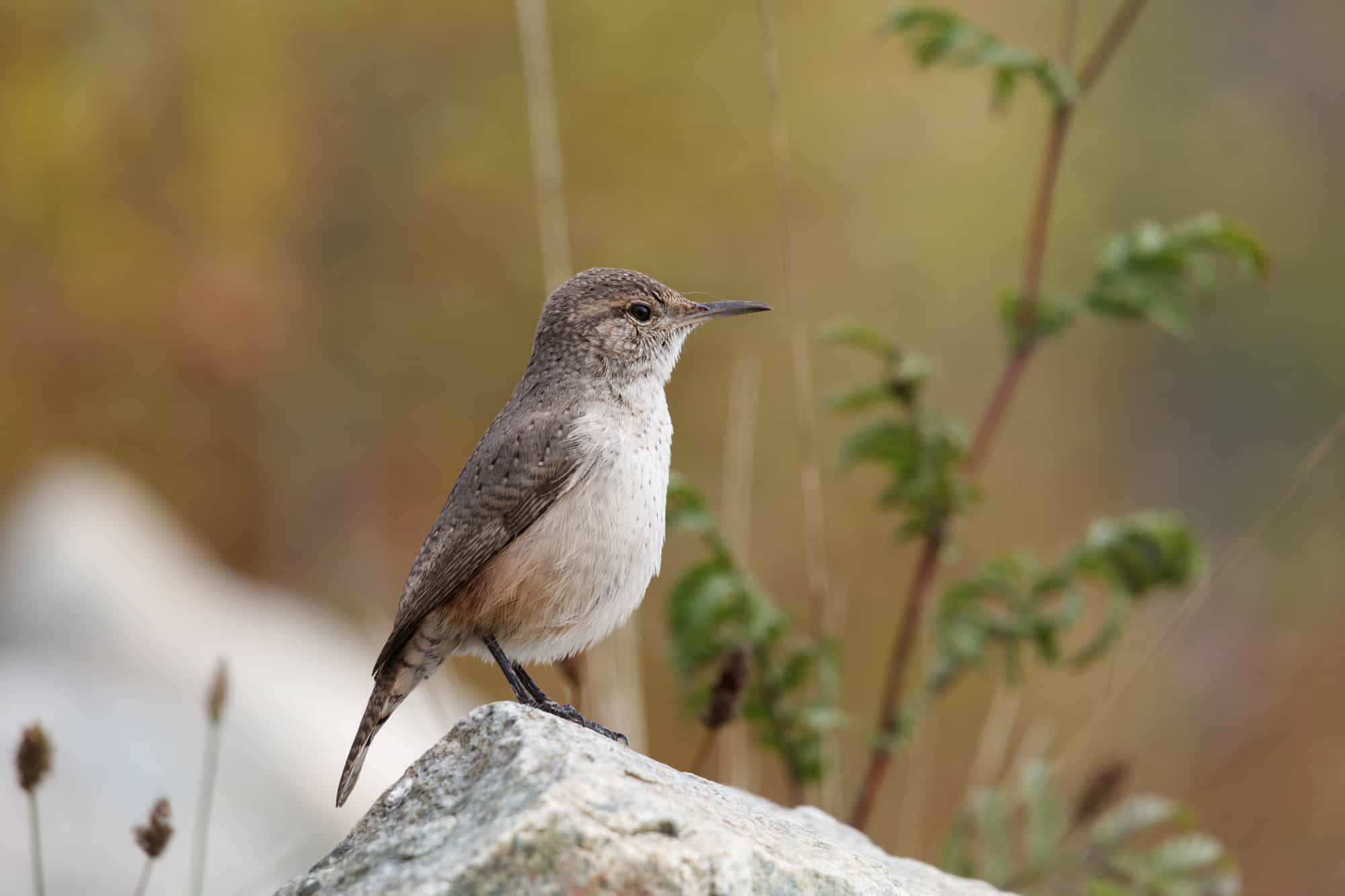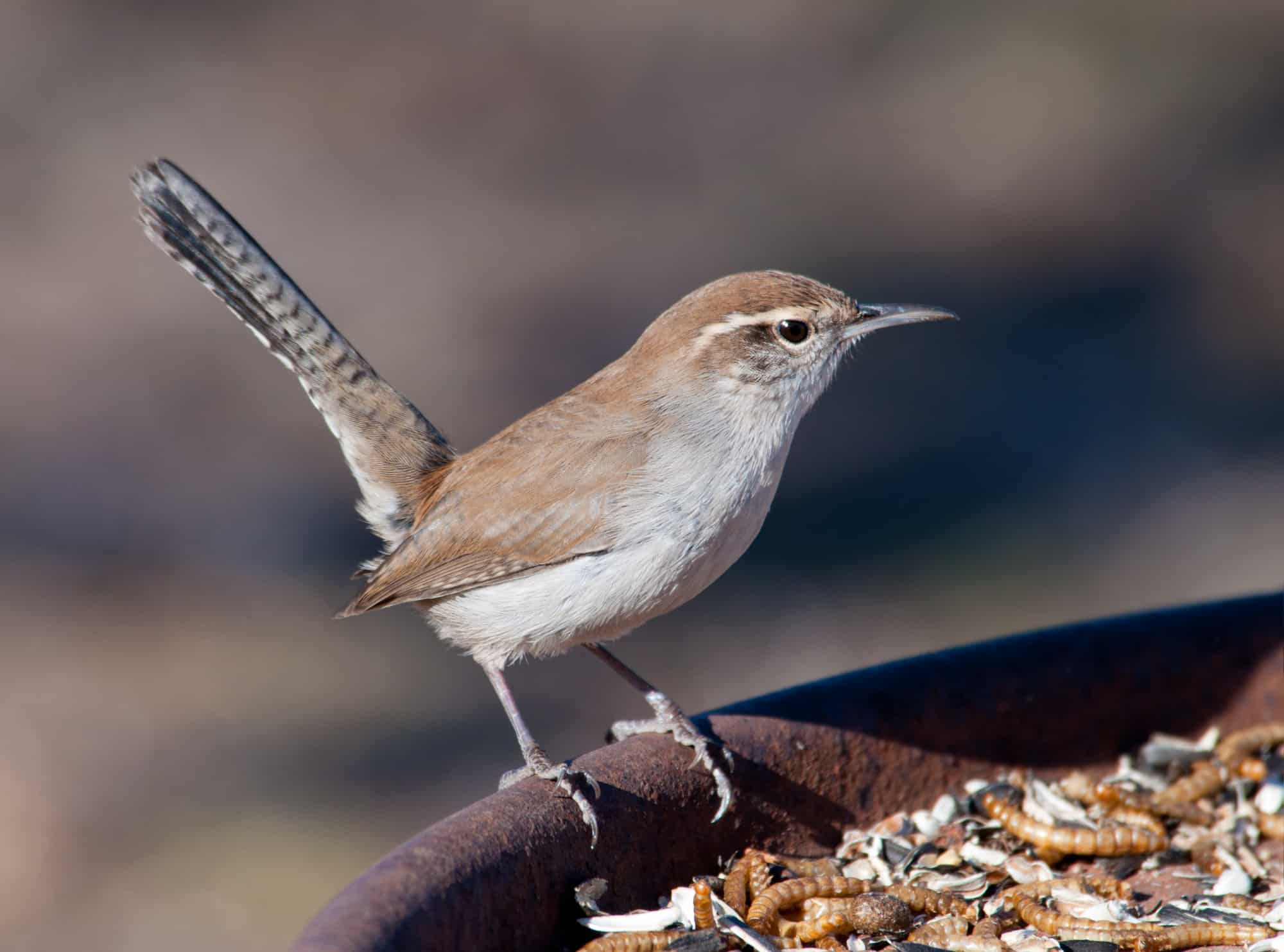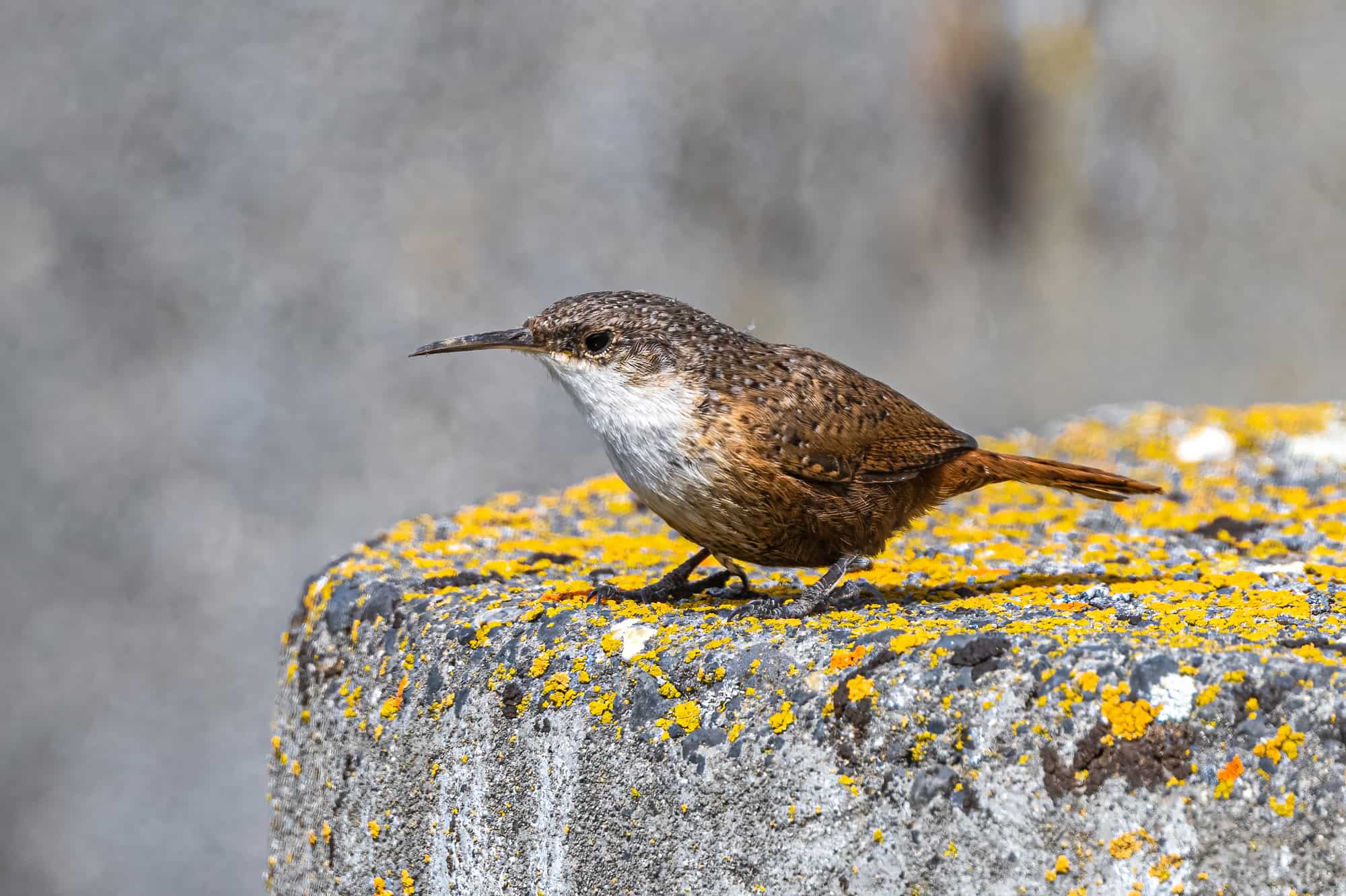North Dakota doesn’t get a lot of credit for being a fascinating state. On top of providing a significant chunk of the country’s grain supply, it has a whopping 8 wrens you can spot!
Wrens are a tricky species for birdwatchers since they’re pickier about their environment, generally preferring wetter or shrubby areas. Different types of wrens also share similar appearances, so you’ll want to get your binoculars out for this list.
I’ll help you spot these charming little songbirds with some tips on their appearance, birdsong, and behavioral patterns. Some of these species are common in the state, while others are rarer.
House Wren

- Species Name: Troglodytes aedon
- Length: 11 cm to 13 cm
- Weight: 10 grams to 12 grams
- Wingspan: 15 cm
Similar to the house finch, the house wren is among the best-known of their species. Their wide range and unique singing voice make them a treat to spot.
Appearance
The house wren is a subtle bird with a classically round body and long, thin beak. They’re generally a light gray-brown with darker wings and a striped tail.
Like most wrens, female and male house wrens look identical.
Range
The house wren is a common sight all throughout North Dakota during breeding season. They become much more scarce during winter due to migration.
While some wren species prefer wetter areas, the house wren is content to explore forests and suburban locations. You’ll just as likely find one in your backyard as you would in the tangled undergrowth of a forest trail.
Diet
House wrens are quite fond of insects and will spend much of their time scrounging around for a meal on the forest floor. They’ll eat their fill of caterpillars, spiders, and beetles – they also like snails!
Unless you like digging around for insects, attract them to your backyard with brush piles and bushels of leaves. These cluttered locations attract insects, which in turn attract house wrens!
Birdsong
I’m endlessly fascinated with the house wren’s jumbled and dynamic bird call. They’ll shift from cheeping to warbling to sounding like a laser from a 40’s sci-fi flick.
Fun Fact
House wrens are bold birds who will build their nests just about anywhere. However, they’re more than happy to take refuge in a human-built birdhouse!
Carolina Wren

- Species Name: Thryothorus ludovicianus
- Length: 12 cm to 14 cm
- Weight: 18 grams to 22 grams
- Wingspan: 29 cm
Now for a wren that’s much less common in North Dakota. This accidental bird species has been spotted a few times by particularly sharp-eyed birders, so it’s worth keeping an eye out for!
Appearance
The Carolina wren is a little more distinctive from other members of the family due to their big, white eye stripe. They have warm brown wings and a toasty orange-brown belly.
As is typical with wrens, both males and females look similar. However, males tend to have slightly longer beaks and tails.
Range
These elusive wrens show up sporadically in North Dakota, but they’re quite keen on visiting backyard feeders. If you’re a backyard birder with a hearty helping of patience, you may spot a few visiting during the winter.
Diet
Carolina wrens have an incredibly diverse diet – while they usually prefer insects, they also eat millipedes and snails. They’ll even eat frogs and lizards when they get the chance.
Once the weather turns cold and food gets scarce, they’ll try a few seeds or berries. Keep your feeder stocked with sunflower seeds, mealworms, or suet once it gets cold.
Birdsong
This wren has a distinctive call of brisk, repetitive warbles. Listen closely for soft twer-her-twer-her notes.
Fun Fact
Carolina wrens are dedicated birds. It’s common for breeding pairs to stay together for many years.
Marsh Wren

- Species Name: Cistothorus palustris
- Length: 10 cm to 14 cm
- Weight: 9 grams to 14 grams
- Wingspan: 15 cm
While North Dakota is well-known for its beautiful prairies, did you know it also has quite a few marshlands? As such, the marsh wren is quite at home here.
Appearance
The marsh wren is a charming little bird with a dusty brown body, a light belly, and a dark brown cap. Their wings and tail have a cute, speckled black-and-white pattern.
Their most distinctive feature is how their tail sticks straight up like a flag. Both male and female marsh wrens look the same.
Range
These wrens show up throughout most of the state during breeding season. They tend to move through the southwestern portion of the state during migration.
Despite the state’s well-tended marshlands, the marsh wren is a little tricky to spot. This fact is due to their preference for wetland habitats rather than parks or backyards.
Diet
Spiders and insects are the go-to meal for the marsh wren. They’re not inclined to visit a backyard feeder, but don’t lose hope!
If you feel like going on a nature walk through North Dakota’s marshlands, keep a close eye out for these birds. They like to cling to reeds where they can fish for abundant insect food or let out their distinctive call.
The Arrowwood Wetland Management District in North Dakota has several wildlife refuges where you can take photos, fish, and more. Several of these locations are just right for spotting marsh wrens in their natural habitat.
Birdsong
Their call may not be elegant, but it’s incredibly unique! Marsh wrens let out repetitive, buzzy notes that sound like opening and closing a zipper.
Fun Fact
Marsh wrens have a unique migratory pattern. Older birds tend to stay put, while younger birds are quicker to leave.
Rock Wren

- Species Name: Salpinctes obsoletus
- Length: 12 to 15 cm
- Weight: 15 grams to 18 grams
- Wingspan: 22 cm to 24 cm
Despite their scientific name, the rock wren is not obsolete in North Dakota! These birds have bouncy and expressive body language that makes them a little easier to spot at a distance.
Appearance
The rock wren earns its name for how easily it blends into its stony, earthy environment. Their bodies are a slate gray-brown with lighter barring along their wings and tail.
They have a long, white eyebrow stripe and a slightly more pale stomach.
Range
North Dakota is a fantastic hiking location, so make sure to mark this bird down on your spotting list. Their preferred habitats are dry and rocky locations, particularly in the western portion of the state during breeding season.
Little Missouri State Park is located within their range and has plenty of winding trails for hiking and horseback riding.
Diet
Similar to other wren species, the rock wren is quite fond of insects and spiders. They’ll sometimes eat ants and earthworms.
This isn’t a wren you’ll see at a feeder, so try to find them in their natural habitat among North Dakota’s buttes and trails.
Birdsong
It’s hard to narrow down the rock wren’s call because they…don’t technically have one! They have several, ranging from repetitive chirps to long, smooth trills.
Fun Fact
The rock wren is incredibly hardy, rarely drinking water and getting their moisture instead from the food they eat.
Sedge Wren

- Species Name: Cistothorus stellaris
- Length: 10 cm to 12 cm
- Weight: 7 grams to 10 grams
- Wingspan: 12 cm to 14 cm
If you want to really challenge your attention to detail, try and tell the difference between a sedge wren and a marsh wren. I’ll help you, of course!
Appearance
The sedge wren has a cinnamon-brown body with darker barring around its wings and tail. They also have a streak over their eye, though it’s a little subtle.
The biggest difference between a sedge wren and a marsh wren is the stomach. Marsh wrens have lighter stomachs, while sedge wrens are more uniform.
Range
You won’t find these birds in dry and rocky areas. Sedge wrens prefer to make their homes in wetlands and marshes where they can hop between stalks of grass.
These birds are most common in North Dakota in the eastern portion of the state, particularly during breeding season.
Diet
Did someone say spiders? While this is the sedge wren’s favorite food, they’ll also nibble on caterpillars, beetles, and grasshoppers.
If you enjoy browsing nature trails, look closely at tall grasses and wet areas for these cute little birds.
Birdsong
This wren’s call is simple, yet remarkably distinctive. They let loose sparse, bright chit-chits followed by long, buzzing trills.
Fun Fact
The sedge wren is an impressive weaver, crafting its nests out of twined grass and feathers.
Bewick’s Wren

- Species Name: Thryomanes bewickii
- Length: 13 cm
- Weight: 8 grams to 12 grams
- Wingspan: 18 cm
It’s curveball time! The Bewick’s wren is another accidental species in North Dakota, but you could come across them when you least expect it.
Appearance
The Bewick’s wren has a coloration more similar to a seabird than a wren, composed of a light brown with a bright white stomach. Their incredibly long tail has a light gray-blue coloration.
Range
This wren is a big fan of shrubby and lush locations. If you plan on hiking or driving across North Dakota’s countryside, look to the overgrown areas.
Diet
This wren dines primarily on insects such as caterpillars, beetles, and bees. They’ll also scoop up any larvae they find.
They’re not opposed to visiting bird feeders, either. See if you can spot one with the aid of mealworms or suet during the winter.
Birdsong
This bird has a bright and swooping call. If you’re one of the lucky few who can spot them, you may hear chirps followed by warbling trills.
Fun Fact
The Bewick’s wren is a tricky bird to classify and may have up to 19 different subspecies!
Winter Wren

- Species Name: Troglodytes hiemalis
- Length: 8 cm to 12 cm
- Weight: 8 grams to 12 grams
- Wingspan: 12 cm to 16 cm
Curious about another accidental species? Winter wrens are more common in Canada and the United States East Coast, but they sometimes pop up outside of their normal range.
Appearance
This tiny, round bird has a warm brown body with darker barring on its wings, belly, and tail. A particularly sharp eye will notice they have flecks of white on their wing bars and a white eyebrow stripe.
Range
The winter wren generally prefers dense, coniferous forests where they can forage and hide from other animals. Since North Dakota is rather light on forests, your best chance of finding them is through your backyard.
Diet
Caterpillars and spiders are the winter wren’s go-to, particularly in tangled undergrowth where insect activity thrives.
If you’re a birder who enjoys a little exterior design, try creating a more dense and overgrown backyard. This location more closely mimics their natural habitat and may entice them to visit.
Birdsong
This bird is worth keeping an eye out for due to their beautiful, sweet call. Expect to hear high, smooth warbles and chitters that almost sound finch-like.
Fun Fact
Rotten tree stumps may not be our idea of a great place to hang out, but the winter wren thinks otherwise. They regularly build their nests here, which also doubles as a ready food source when insects scurry inside.
Canyon Wren

- Species Name: Catherpes mexicanus
- Length: 11 cm to 15 cm
- Weight: 9 grams to 18 grams
- Wingspan: 18 cm to 20 cm
Last but not least, we have darling canyon wrens. This species is accidental in North Dakota, but well worth the effort due to their beautiful plumage.
Appearance
Canyon wrens are able to blend into their environment easily with their toasty brown bodies and speckled gray heads. Their white belly and barred tail remind me a little of pheasants and sparrows.
While both birds look similar, males tend to sing more often.
Range
These birds usually stick to deep canyons and rolling, rocky terrain. While they more frequently show up in Canada and Mexico, they’ll crop up in pockets throughout the United States.
Since North Dakota is home to beautiful canyons, you’ll want to keep a sharp eye out for these birds in their natural habitat. They like to cling to the sides of rocks where they’ll peck for food.
Diet
Canyon wrens regularly clamber up and down rocks to fish out the spiders hiding inside. They’ll also eat any other insect they can get their beak on.
Similar to the rock wren, they don’t usually drink water since their food supplies them with plenty.
Birdsong
Now this is an interesting and distinctive song! This bird’s rising and falling whistle has the exact same cadence as someone laughing and trailing off.
Fun Fact
While canyon wren baby birds are able to leave the nest after two weeks, they like to stick around for far longer.
North Dakota Is a Delightful Challenge for Sharp-Eyed Birders
With a hearty helping of regular and accidental wrens, North Dakota is a fantastic challenge for birders. You’ll sharpen both your ability to identify these tricky birds as well as hold out for the rarer ones.
The state is home to quite a few rocky trails and parks, so consider visiting the Little Missouri State Park to spot rock wrens. If you prefer fishing or snapping shots of greenery, try the Arrowwood Wetland Management District instead.
I highly recommend getting a pair of binoculars when spotting wrens due to their visual similarities. Even the sharpest eye may miss subtle details like flecks on wings or eyebrow stripes.
This state is filled with abundant bird life for passionate bird watchers. Our guide on birds in North Dakota breaks down how to spot swallows, woodpeckers, meadowlarks, and more!

